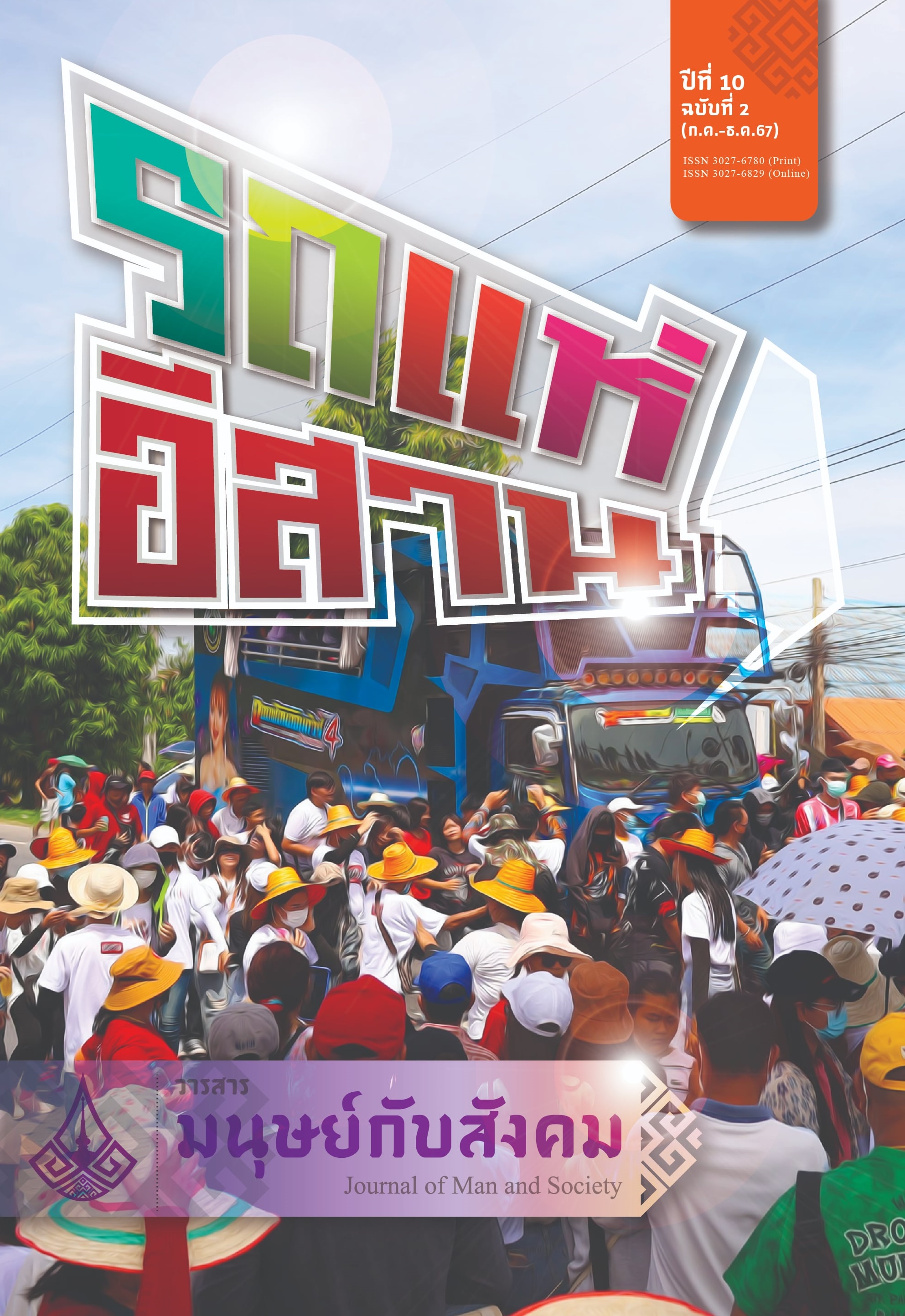Gourd Pattern: A Study of Human Origin Motifs in the Lahu Ethnic Group, Ban Huay Pla Kang Community, Rim Kok Subdistrict, Mueang Chiang Rai District, Chiang Rai Province
Main Article Content
Abstract
This qualitative research paper was conducted within the Lahu ethnic community of Ban Huay Pla Kang, Rim Kok Subdistrict, Mueang Chiang Rai District, Chiang Rai Province, Thailand. The study aimed to investigate the motifs of human origin as reflected in the gourd myth of the Luha ethnic group in Ban Huay Pla Kang Community and investigate the persistence and transformation of the symbolic meaning of the gourd in the clothing of the Lahu ethnic group in the same community. Data were collected through in-depth interviews. The findings revealed that the motifs of human origin in the Lahu gourd myth share similarities with the origin stories of many other ethnic groups. These motifs reflect the social development and cultural beliefs of the Lahu people before the adoption of newer religious practices. Regarding the symbolic meaning of the gourd in the Luhu clothing, the study found that the gourd was historically a significant symbol for the community, with gourd patterns commonly embroidered on traditional Lahu shirts. However, new beliefs introduced to the community have influenced their traditional practices. As a result, the Black Lahu of Ban Huay Pla Kang have reduced the importance of the gourd story and its symbolic patterns in their clothing to adapt to the evolving societal context of their region.
Article Details

This work is licensed under a Creative Commons Attribution-NonCommercial-NoDerivatives 4.0 International License.
เนื้อหาและข้อมูลที่ตีพิมพ์ลงในวารสารมนุษย์กับสังคม ถือเป็นข้อคิดเห็นและความรับผิดชอบโดยตรงของผู้เขียนซึ่งกองบรรณาธิการวารสารไม่จำเป็นต้องเห็นด้วยหรือร่วมรับผิดชอบใดๆ
บทความ ข้อมูล เนื้อหา รูปภาพ ฯลฯ ที่ได้รับการตีพิมพ์ในวารสารมนุษย์กับสังคม ถือเป็นลิขสิทธิ์ของวารสาร หากบุคคลหรือหน่วยงานใดต้องการนำทั้งหมดหรือส่วนหนึ่งส่วนใดไปเผยแพร่ต่อต้องอ้างอิงวาสาร
References
กองบรรณาธิการศิลปวัฒนธรรม. (2566, 10 พฤศจิกายน). โบราณว่าน้ำเต้าหน้าตาเหมือนมดลูก. silpa-mag. https://www.silpa-mag.com/culture/article_20387
จุฑาพรรธ์ (จามจุรี) ผดุงชีวิต. (2551). วัฒนธรรม การสื่อสาร และอัตลักษณ์ (พิมพ์ครั้งที่ 2). บริษัทแอคทีฟ พริ้นท์ จำกัด.
ชาญยุทธ สอนจันทร์. (2559). ผ้าผะเหวดอีสาน: โครงสร้างของนิทาน, อนุภาคตัวละครและภาพสะท้อนวิถี วัฒนธรรมท้องถิ่น. วารสารวิถีสังคมมนุษย์, 4(1), 283-293.
ไชยรัตน์ เจริญสินโอฬาร. (2555). สัญวิทยา โครงสร้างนิยม หลังโครงสร้างนิยมกับการศึกษารัฐศาสตร์ (พิมพ์ครั้งที่ 2). สำนักพิมพ์วิภาษา.
ปฐม หงษ์สุวรรณ. (2550). กาลครั้งหนึ่ง: ว่าด้วยตำนานกับวัฒนธรรม (พิมพ์ครั้งที่ 2). สำนักพิมพ์แห่งจุฬาลงกรณ์มหาวิทยาลัย.
ปาริชาต เกษมสุขและทิพวรรณ ทั่งมั่งมี. (2566). ผ้าทอไทลื้อสื่อศรัทธาสู่ศิลปะร่วมสมัย. วารสารสันติศึกษาปริทรรศน์ มจร, 11(6), 1-14.
พงศาวดารล้านช้าง. (2506). ประชุมพงศาวดาร เล่ม 2. พระนคร: คุรุสภา.
พงศาวดารเมืองแถง. (2507). ประชุมพงศาวดาร เล่ม 9. พระนคร: คุรุสภา.
ราชบัณฑิตยสถาน. (2542). พจนานุกรม ฉบับราชบัณฑิตยสถาน. นานมีบุ๊คส์พับลิเคชั่น.
ศิราพร ณ ถลาง. (2542). ตำนานสร้างโลกของชนชาติไท : ตัวอย่างการศึกษาวัฒนธรรมจากตำนานในสังคมและวัฒนธรรมในประเทศไทย. ศูนย์มานุษยวิทยาสิรินธร.
ศิราพร ณ ถลาง. (2548). ทฤษฎีคติชนวิทยา วิธีวิทยาในการวิเคราะห์ตำนาน - นิทานพื้นบ้าน. โครงการเผยแพร่ผลงานทางวิชาการ คณะอักษรศาสตร์ จุฬาลงกรณ์มหาวิทยาลัย.
สร้างเมืองล้านช้าง. (2506). ประชุมพงศาวดารเล่ม 2. คุรุสภา.
สมบัติ บุญคำเยือง. (2550). รายงานวิจัย เรื่อง การศึกษาทางชาติพันธุ์วรรณนาว่าด้วยการเปลี่ยนแปลงของชุมชนคนชายขอบกรณีศึกษา ลาหู่และไท-ยวนบ้านป่า จังหวัดเชียงราย. สำนักงานคณะกรรมการวิจัยแห่งชาติ.
สุจิตต์ วงษ์เทศ. (2561, 27 กรกฎาคม - 2 สิงหาคม). น้ำเต้าทำแคนแหล่งกำเนิดมนุษย์. มติชนสุดสัปดาห์.
เสาวลักษณ์ อนันตศานต์. (2558). อนุภาคเหนือธรรมชาติในนิทานเรื่องสังข์ทอง. วารสารรามคำแหง (ฉบับมนุษยศาสตร์). 34(2), 1-21.
เอกลักษณ์และศิลปะลวดลายบนผืนผ้า. (2560, 2 พฤศจิกายน). ผ้าทอชนเผ่ามูเซอ (ลาหู่). sacit. www.sacit.or.th.
Authony R. W. (1995). Mvuh Hpa Mi Hpa CREATING HEAVEN , CREATING EARTH An Epic Myth of the Lahu People in Yunnan. Printed in Thailand by O.S. Printing House.

